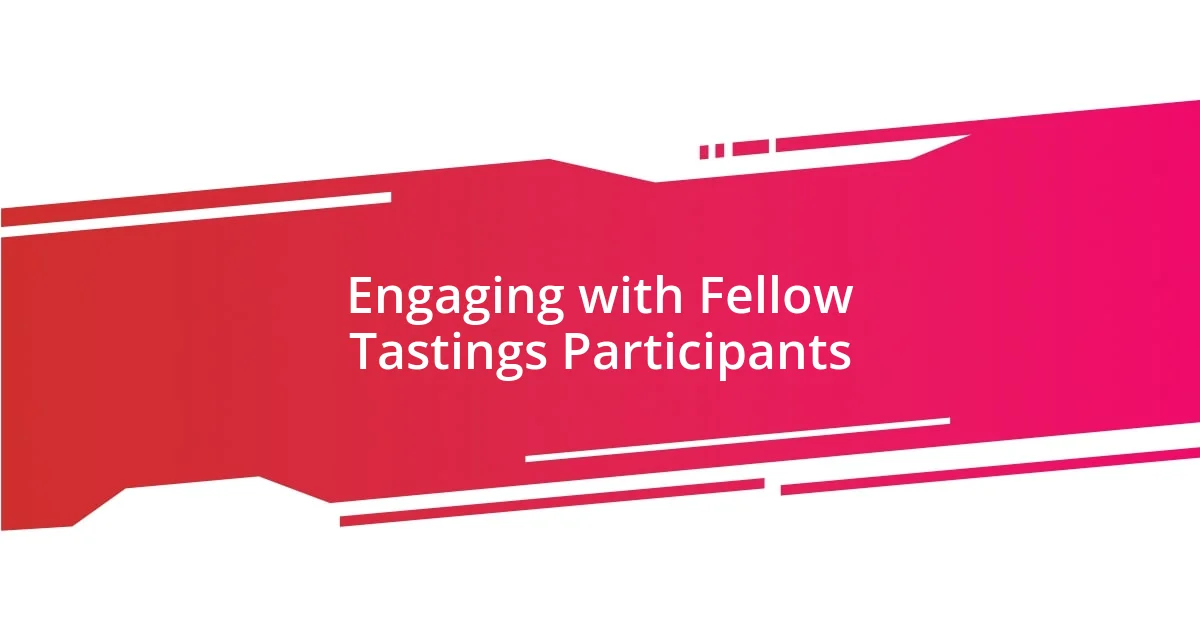Key takeaways:
- Happy hour tastings create a lively atmosphere that fosters connections and enhances the overall experience through shared passion for food and drink.
- Understanding tasting fundamentals, like themes, flight approach, and palate cleansers, is crucial for fully appreciating flavors and the stories behind them.
- Engaging with fellow participants and reflecting on personal experiences during tastings enriches the overall enjoyment and sense of community.

Introduction to Happy Hour Tastings
Happy hour tastings are a delightful way to explore new flavors and connect with others, all while unwinding after a long day. I still remember my first experience at a local tasting event—it was like a mini-vacation from my routine. Surrounded by bright chatter and laughter, I savored unique drinks and delectable bites, feeling a sense of community and excitement in every sip.
Walking into a happy hour tasting, one can’t help but wonder what culinary surprises await. Have you ever been surprised by a flavor combination that you thought would never work? I certainly have; I still recall the day I discovered the refreshing blend of grapefruit and rosemary in a cocktail. It opened my eyes to the creativity of mixology and the endless possibilities of flavor.
These tastings are not just about the drinks, though; they create an atmosphere where conversation flows as freely as the beverages. I often find myself chatting with strangers who share my passion for good food and drink. It’s remarkable how a shared experience, like tasting a well-crafted cocktail, can foster connections and spark engaging conversations about favorite flavors or dining adventures.

Understanding the Basics of Tastings
Understanding the fundamentals of tastings is crucial for fully appreciating the experience. Each tasting event typically revolves around a specific theme or type of beverage—be it wines, cocktails, or craft beers. I remember my first wine tasting, where the sommelier explained how to assess the wine’s color, aroma, and body. It was a revelation that transformed the way I appreciated each sip, allowing me to savor not just the flavors but the stories behind them.
As you delve into the world of tastings, it’s essential to grasp the various elements involved. For instance, understanding the flight approach, where multiple drinks are served side by side for comparison, can enhance your tasting experience. This method not only allows you to differentiate flavors better but also immerses you in a sensory adventure. I was once part of a craft beer tasting that pitted fruity IPAs against rich stouts, an unforgettable side-by-side experience that ignited my passion for appreciating the craft behind each brew.
Observing the nuances in each drink can significantly elevate your tasting journey. Consider the significance of palate cleansers—small bites between samples to reset your taste buds—and how they impact your perception of flavors. At a recent tasting, I tried paired cheeses that transformed a straightforward wine into a complex narrative of flavors, offering insights into how certain combinations can enhance your overall experience. It’s these little details that make tastings both enjoyable and informative.
| Aspect | Description |
|---|---|
| Themes | Specific focus like wine, cocktails, or beers. |
| Flight Approach | Serving multiple drinks together for comparison. |
| Palate Cleansers | Small bites to reset taste buds between samples. |

Pairing Food with Your Tastings
Pairing food with your tastings can elevate the entire experience. I once attended a whiskey tasting where the organizer paired smoked brisket sandwiches with different bourbons. Each sip of whiskey danced harmoniously with the smoky, savory notes of the meat. It was like they were created for each other, and I found myself repeatedly going back for more. The right food can enhance flavors, transforming an average tasting into a memorable journey.
When it comes to pairing, consider these combinations:
- Wine and Cheese: A classic duo; for instance, bold reds often pair beautifully with sharp cheddar.
- Beer and Pretzels: The saltiness of pretzels can beautifully complement light lagers or IPAs.
- Cocktails and Appetizers: Spicy cocktails like a jalapeño margarita go perfectly with sweet corn fritters.
- Spirits and Dark Chocolate: Rich dark chocolate can amplify the flavors in an aged rum or whiskey.
These combinations create a canvas for your palate, revealing new dimensions of flavors with every bite and sip.

Engaging with Fellow Tastings Participants
Engaging with fellow participants during tastings can be one of the most delightful aspects of the experience. I recall attending a gin tasting where the excitement was palpable; everyone shared their thoughts about the botanicals in each sample. It struck me how quickly strangers can connect over a shared passion, sparking lively discussions about favorite gins and personal recipes. Have you ever found yourself in a conversation where you felt the energy of collective curiosity? It’s incredibly invigorating.
I often find that sharing personal anecdotes about the drinks can deepen connections. During one tasting, I mentioned my memorable trip to Scotland, where I hiked through a distillery’s gardens, gathering a profound appreciation for the herbs that flavored the gin. Other participants chimed in with their own travel stories and flavor preferences, transforming a simple tasting into a rich dialogue of shared experiences. There’s something about stories that makes flavors come alive, don’t you think?
Moreover, I’ve learned that asking questions can enhance engagement. At a recent craft beer tasting, I posed a curious question about the brewing process behind a tart sour ale, and suddenly, everyone wanted to chime in with their insights and preferences. It was mesmerizing how this simple question created a moment of camaraderie. The exchange of knowledge and personal experiences made that tasting so much more than just sipping beverages; it became a celebration of community and shared interests.

Reflecting on Your Tasting Experience
Reflecting on my tasting experiences often brings a flood of emotions and memories. I vividly recall a vibrant wine tasting where I first tried a bold Zinfandel. The rich, jammy notes whisked me back to lazy summer afternoons spent with friends, enjoying good company and laughter. Isn’t it amazing how a single sip can transport you to a different time and place?
What I’ve come to appreciate during tastings is the importance of taking a moment to reflect on each flavor profile. I once attended a craft cocktail event where I savored a rosemary-infused gin fizz. After sipping, I closed my eyes and let the herbal notes linger on my palate while contemplating the cocktail’s ingredients. That moment of mindfulness allowed me to fully understand the complexity of the drink. Have you ever paused during a tasting to dive deeper into what you’re experiencing?
Moreover, I’ve learned that maintaining a tasting journal can significantly enhance the reflection process. After my last whiskey tasting, I jotted down my thoughts and feelings about each spirit. Not only did this practice help solidify my preferences, but it also poured out memories related to the tastes. Remembering a friend’s laughter during a particular whiskey sip made the experience more cherished. Don’t you find that intentional reflection can transform an ordinary tasting into something truly special?















